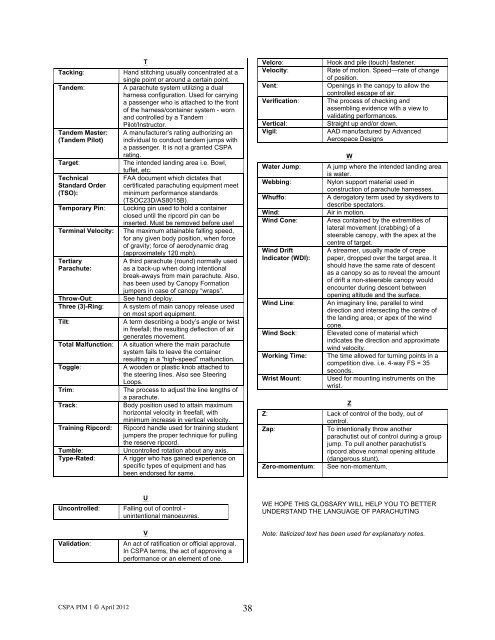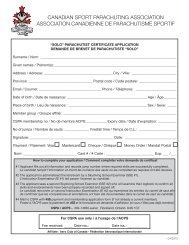PIM 1 2012 Final - Canadian Sport Parachuting Association
PIM 1 2012 Final - Canadian Sport Parachuting Association
PIM 1 2012 Final - Canadian Sport Parachuting Association
Create successful ePaper yourself
Turn your PDF publications into a flip-book with our unique Google optimized e-Paper software.
T<br />
Tacking: Hand stitching usually concentrated at a<br />
single point or around a certain point.<br />
Tandem: A parachute system utilizing a dual<br />
harness configuration. Used for carrying<br />
a passenger who is attached to the front<br />
of the harness/container system - worn<br />
and controlled by a Tandem<br />
Pilot/Instructor.<br />
Tandem Master:<br />
(Tandem Pilot)<br />
A manufacturer’s rating authorizing an<br />
individual to conduct tandem jumps with<br />
a passenger. It is not a granted CSPA<br />
rating.<br />
Target: The intended landing area i.e. Bowl,<br />
tuffet, etc.<br />
Technical<br />
FAA document which dictates that<br />
Standard Order certificated parachuting equipment meet<br />
(TSO):<br />
minimum performance standards<br />
(TSOC23D/AS8015B).<br />
Temporary Pin: Locking pin used to hold a container<br />
closed until the ripcord pin can be<br />
inserted. Must be removed before use!<br />
Terminal Velocity: The maximum attainable falling speed,<br />
for any given body position, when force<br />
of gravity; force of aerodynamic drag<br />
(approximately 120 mph).<br />
Tertiary<br />
A third parachute (round) normally used<br />
Parachute: as a back-up when doing intentional<br />
break-aways from main parachute. Also,<br />
has been used by Canopy Formation<br />
jumpers in case of canopy “wraps”.<br />
Throw-Out: See hand deploy.<br />
Three (3)-Ring: A system of main canopy release used<br />
on most sport equipment.<br />
Tilt: A term describing a body’s angle or twist<br />
in freefall; the resulting deflection of air<br />
generates movement.<br />
Total Malfunction: A situation where the main parachute<br />
system fails to leave the container<br />
resulting in a “high-speed” malfunction.<br />
Toggle: A wooden or plastic knob attached to<br />
the steering lines. Also see Steering<br />
Loops.<br />
Trim: The process to adjust the line lengths of<br />
a parachute.<br />
Track: Body position used to attain maximum<br />
horizontal velocity in freefall, with<br />
minimum increase in vertical velocity.<br />
Training Ripcord: Ripcord handle used for training student<br />
jumpers the proper technique for pulling<br />
the reserve ripcord.<br />
Tumble: Uncontrolled rotation about any axis.<br />
Type-Rated: A rigger who has gained experience on<br />
specific types of equipment and has<br />
been endorsed for same.<br />
Uncontrolled: Falling out of control -<br />
unintentional manoeuvres.<br />
U<br />
V<br />
Validation: An act of ratification or official approval.<br />
In CSPA terms, the act of approving a<br />
performance or an element of one.<br />
CSPA <strong>PIM</strong> 1 © April <strong>2012</strong> 38<br />
Velcro: Hook and pile (touch) fastener.<br />
Velocity: Rate of motion. Speed—rate of change<br />
of position.<br />
Vent: Openings in the canopy to allow the<br />
controlled escape of air.<br />
Verification: The process of checking and<br />
assembling evidence with a view to<br />
validating performances.<br />
Vertical: Straight up and/or down.<br />
Vigil: AAD manufactured by Advanced<br />
Aerospace Designs<br />
W<br />
Water Jump: A jump where the intended landing area<br />
is water.<br />
Webbing: Nylon support material used in<br />
construction of parachute harnesses.<br />
Whuffo: A derogatory term used by skydivers to<br />
describe spectators.<br />
Wind: Air in motion.<br />
Wind Cone: Area contained by the extremities of<br />
lateral movement (crabbing) of a<br />
steerable canopy, with the apex at the<br />
centre of target.<br />
Wind Drift<br />
Indicator (WDI):<br />
A streamer, usually made of crepe<br />
paper, dropped over the target area. It<br />
should have the same rate of descent<br />
as a canopy so as to reveal the amount<br />
of drift a non-steerable canopy would<br />
encounter during descent between<br />
opening altitude and the surface.<br />
Wind Line: An imaginary line, parallel to wind<br />
direction and intersecting the centre of<br />
the landing area, or apex of the wind<br />
cone.<br />
Wind Sock: Elevated cone of material which<br />
indicates the direction and approximate<br />
wind velocity.<br />
Working Time: The time allowed for turning points in a<br />
competition dive. i.e. 4-way FS = 35<br />
seconds.<br />
Wrist Mount: Used for mounting instruments on the<br />
wrist.<br />
Z<br />
Z: Lack of control of the body, out of<br />
control.<br />
Zap: To intentionally throw another<br />
parachutist out of control during a group<br />
jump. To pull another parachutist’s<br />
ripcord above normal opening altitude<br />
(dangerous stunt).<br />
Zero-momentum: See non-momentum.<br />
WE HOPE THIS GLOSSARY WILL HELP YOU TO BETTER<br />
UNDERSTAND THE LANGUAGE OF PARACHUTING<br />
Note: Italicized text has been used for explanatory notes.




